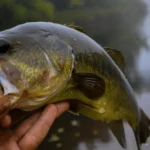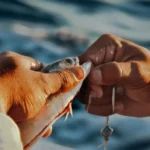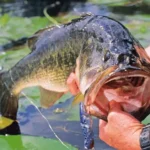Can you bait your hook and wait for the big one to bite? If that’s the case, you may be curious about What pound test for baitcaster is best? The answer to this question will determine the success or failure of your fishing trip. With so many possibilities, selecting the proper pound test for your bait caster is crucial. In order to assist you in making an educated purchase, this essay will explore the world of fishing equipment. So, let’s investigate the issue that’s first in the minds of all fishermen: What pound test for baitcaster is best?
Understanding Pound Test and its Significance
Choosing the proper pound trial for your bait caster reel is crucial, so let’s quickly go over that before getting into the nitty-gritty. The pound ordeal determines how strong and resilient your fishing bar is, which in turn affects how well it can deal with a variety of fish and water conditions. A disappointing and missed opportunity might result from a line that broke under the force of a strong catch because of an inadequate pound quiz. On the other side, using a bar with a pound test that is too high might reduce your throwing distance and make your gear less responsive to light bites.
Factors to Consider When Choosing Pound Test
The optimal pound trial for your bait caster depends on a number of variables. Let’s have a look at these factors so you can make a well-informed choice:
- Target Fish Species: Fish of various kinds have different levels of power and aggressiveness. You’ll need a more assertive streak to keep up with the forceful runs and dives of bigger, more aggressive fish like bass or pike. However, a lighter pound examination is sufficient for landing trout and panfish.
- Fishing Environment: The stripe you choose also depends on the sort of water you’re fishing in. You need a strong rope that can withstand abrasion and snags if you often fish in places with high covers, such as dense foliage or rocky formations. In open water, when stealth and sensitivity are of the utmost importance, a lighter-pound quiz may be preferable.
- Casting Distance: Casting distance may be affected by the pound questioning. Casting distance is reduced when using heavier lines due to increased resistance from the guides. Using a lighter rope can allow you to throw farther if that is an essential aspect of your fishing technique.
- Rod Power and Action: The strength and motion of your rod should be suitable for the pound trial you choose. The power of a rod is a measure of its strength and may be very light or heavy. The line’s strength should be matched to the rod’s power for maximum balance and protection against breaks. As the rod bends and reacts to fish strikes, the action determines how effectively it can control the strength of the bar.
Now that we’ve discussed the basics, we can discuss the various pound ordeal alternatives for bait caster reels.
The Pound Test Spectrum: Exploring Your Options
Bait caster reels come in a wide variety of pound tests, each with advantages and niches in which they excel. Some of the most popular types of pound tests are as follows:
- 4-8 Pound Test: Smaller to medium-sized fish in open and clear water are ideal targets for this lighter-pound difficulty range. Its high sensitivity and broad throwing range make it a favorite among finesse fishermen who target trout and crappie.
- 10-14 Pound Test: This higher-pound trial range is suitable for more powerful fish such as bass, walleye, and catfish. It has an excellent middle ground between toughness and sensitivity, making it useful for a wide range of fishing strategies in both open water and modest cover.
- 16-20 Pound Test: If you often fish in deep cover or go for larger predatory species like muskies or northern pike, you’ll want to choose a rope with a medium-to-heavy pound question. The increased abrasion resistance ensures that it will survive the big fish’s erratic swimming.
- Above 20 Pound Test: Lines heavier than 20 pounds are preferable for fishing for large gamefish or in harsh conditions, such as deep sea fishing or rich saltwater applications. These industrial-strength lines are up to battling a marlin, tuna, or sharks, among other formidable predators.
Tips for Selecting the Best Pound Test for Your Baitcaster Reel
Now that we’ve covered the many choices for bait caster reels’ pound tests, let’s dive into some more advice to help you choose the right one:
- Consider your fishing style: Your choice of pound examination should be based on the methods and type you choose while fishing. Opting for a lower-pound test will give you more sensitivity and delicacy if you love finesse fishing with lightweight lures and delicate presentations. On the other hand, a higher-pound trial will provide the strength necessary to withstand power fishing with larger baits and aggressive retrieves.
- Test the waters: Knowing what kind of fishing circumstances you might expect is crucial. Take your time and look at it; if there are any obstacles or hiding places, you may need a more robust cable. Think about the typical fish size in the region as well. You may prevent disappointment and pipe breaks by switching to a heavier ordeal line if you often catch fish of a specific size.
- Evaluate your bait caster reel’s specifications: The correct range of pound examination may be found in the user manual or on the manufacturer’s website for your bait caster reel. The bar capacity and drag settings of bait caster reels might impact the maximum manageable pound quiz. To get the most out of your rotation and avoid putting extra stress on it, follow these rules.
- Seek advice from fellow anglers: Talk to seasoned fishermen on fishing message boards, in local clubs, or on social media. You may learn a lot from hearing people’s opinions and stories about their experiences with different pound tests. However, other people have different tastes, so it’s essential to look at the issue from different angles.
- Don’t forget about the line material: The effectiveness of a cue cannot be gauged only by its pound examination. The overall strength and durability of a line may be affected by the specific qualities of the material it is made of. Determine which material best suits your fishing requirements and tastes via careful research.
- Experiment and adjust: There is a lot of trial and error involved in determining the ideal pound test for your bait caster reel. When you go fishing, don’t be hesitant to try out a few various pound tests. Consider the fish’s behavior, the fishing environment, and your level of satisfaction with the line’s performance before making any changes.
Maintaining Your Baitcaster Reel and Fishing Line
Suppose you want your bait caster reel and fishing string to last as long as possible and function as well as possible; regular maintenance is a must. Some crucial considerations are listed here.
- Clean your reel regularly: Make sure you give your bait caster reel a thorough cleaning after every outing. To get rid of dust, debris, and leftover salt, use a soft cloth or brush. Check the cable guides, spool, and drag system often. Do not use any substances that might corrode the reel. Instead, use products specifically formulated for cleaning reels, as suggested by the manufacturer.
- Inspect for wear and damage: Always check your bait caster reel for damage or wear. If your lines are fraying, it can be because of damage to the rope guides. Check the spool for any burrs or sharp edges that might snag the bar. Taking care of these concerns quickly will reduce the likelihood of line breaks and facilitate more effortless casting and retrieving.
- Re-spool when necessary: Sunlight, friction, and contact with fish all contribute to the gradual deterioration of fishing lines. If your fishing line is showing signs of wear and tear, it’s time to replace it. Re-spooling should be done in accordance with the manufacturer’s guidelines for uniform tension and enough line capacity.
- Apply lubrication: A baitcasting reel requires a tiny quantity of lubrication to be applied to the bearings, gears, and handle. Lubrication prevents wear and tear on your reel by decreasing friction. Avoid using too much grease or oil since this might cause clogging and other problems.
- Store your gear correctly: Keep your bait caster reel and fishing rod out of direct sunlight and at room temperature when not in use. Protect your equipment from dirt, moisture, and possible drops with a reel cover or case. Having a clean, dry place to store your gear can help it last longer and keep working as intended.
- Check your line regularly: Always check the condition of your fishing line before casting your line. Feel the bar with your fingertips to locate rough patches or vulnerable regions. It’s crucial to replace the line as soon as faults are found to prevent untimely breakdowns.
Your bait caster reel and fishing line will last longer if you follow these care instructions, and you won’t have to replace them as often. If your reel has any unique maintenance requirements, check the manufacturer’s instructions.
Conclusion
In conclusion, there is no universal rule for selecting the ideal pound test for a bait caster. The answer is conditional on a number of variables, including the kind of fish you’re after, the weather, and your preferences. Finding the ideal line weight for your bait caster requires trial and error with several pound tests. If you’re wondering, What pound test for bait caster is best? While you prepare for your next fishing trip, trust your gut. Have a wonderful day out on the water!
What Pound Test for Baitcaster is Best? (FAQs)
1. What pound test line should I use for freshwater fishing with a bait caster?
Use a line with a pound test strength of 10 to 14 while fishing with a bait caster in fresh water. This range of line strength (in pounds) strikes a nice mix between power and finesse, making it suitable for use with many freshwater fish.
2. Can I use a heavier-pound test line on a bait caster for saltwater fishing?
Since saltwater is home to more extensive and vital fish species, a higher-pound test line is recommended for fishing there. Choose a pound test line of 16 to 20 pounds or more, taking into account the species you want to catch and the water temperature.
3. What happens if I use a pound test line that is too light for my bait caster?
When using a bait caster, it’s essential to use the appropriate pound test line. For starters, bigger fish might increase the likelihood of the line snapping while being reeled in. Second, if you’re using a lighter line, you may not be able to load the rod with enough weight to throw far or accurately.
4. Can I use a braided line on a bait caster?
Because of their low diameter and excellent strength, bait casters often utilize braided lines. Keep in mind that braided lines are usually rated at a greater power than their corresponding monofilament lines when deciding on a pound test. For comparison, a 6- or 8-pound monofilament line’s diameter could be comparable to that of a 20-pound braided line.
5. How often should I test and adjust the pound test line on my bait caster?
After landing a large catch or experiencing difficulties, it is a good idea to do a line strength test. Look for evidence of damage, fraying, or wear as well. If you detect any issues, you must get the line replaced immediately to avoid poor performance or breakdowns.











